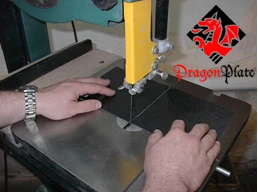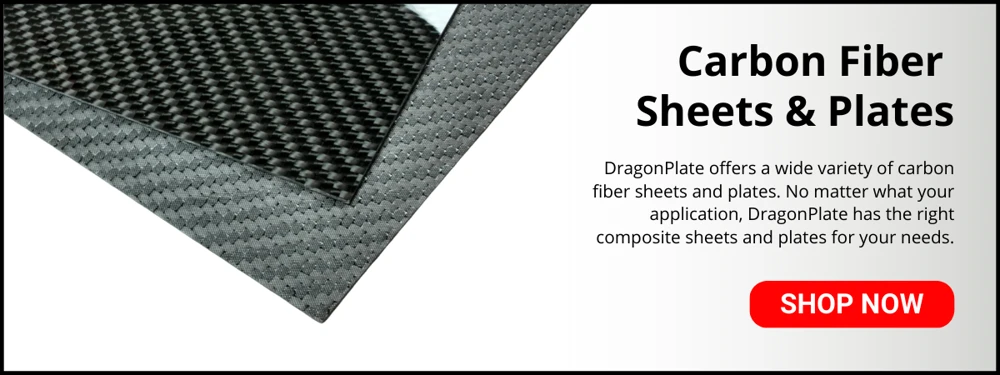How to Cut Carbon Fiber

Carbon fiber is a strong material that can be difficult to cut. Fortunately, there are many ways to get the job done a little easier! In this blog post, we will discuss how you can safely and efficiently cut carbon fiber.
Carbon Fiber Cutting 101
Dragonplate's Carbon Fiber products are easy to cut with the right tools. You can use a bandsaw, scrollsaw, jigsaw, or table saw with a fine-tooth carbide blade. You can also use a CNC router with a carbide bit. For smaller work, a Dremel tool can be used. Once cut, edges can be finished with light sandpaper or a file. We recommend sanding your edges to ensure they are smooth.
The Best and Safest Way to Cut Carbon Fiber Sheets
When selecting tools to cut carbon fiber sheets, consider that the cutting edge of the tool should be as fine as possible. Course-cutting tools can splinter, fracture, or chip the carbon fiber sheet. The best blades for this purpose will have fine grit on the cutting edge rather than teeth. If you do opt for a tool with cutting teeth rather than an abrasive edge, the teeth should be as fine as possible, such as tools designed for metalworking rather than woodcutting. Be aware that cutting carbon fiber sheets will create more wear and tear on your cutting blades than other materials.
When preparing to cut your carbon fiber sheets, always mark your cut first, and then cut slightly wide of that mark. This allows room to sand the carbon fiber sheet back slightly to remove any chips or splinters that might occur, ensuring a smooth, accurate edge.
Use a cutting surface such as wood or high-density foam block to rest your carbon fiber sheet on, allowing the cut piece to fall to the work surface below.
Tools for Cutting Carbon Fiber Sheets
There are a variety of basic tools that work well for cutting carbon fiber sheets. Here are a few options:
Hacksaw: A metal hacksaw fitted with a fine-grit blade works well for straight cuts on prepreg carbon fiber sheets.
Dremel tool: For more complicated shapes, a Dremel or similar rotary tool fitted with a tungsten carbide wheel is a great option.
Drill: If you need to cut a piece from the interior of a carbon fiber sheet, use an electric drill fitted with a metalworking bit to create a pilot hole.
Coping saw: Once you drill the pilot hole, use a coping saw with an appropriate blade to make the cut. Open the coping saw, thread the blade through the pilot hole, then screw the saw back together and make your cuts.
Angle grinder: An angle grinder will cut a bigger job very quickly. This option is best for cutting straight lines very quickly and smoothly. Because it goes so fast, it is easier to make a mistake, though, so exercise caution.
Jigsaw: A jigsaw fitted with a tungsten carbide blade is a great tool for making curved, profiled, or intricate cuts.
Cutting Carbon Fiber with a CNC
Cutting carbon fiber with a CNC mill or router will give you precise cuts, and the ability to produce complex shapes when cutting.
When using a CNC mill or router to cut our carbon fiber sheets, we recommend you use a 1/8" Burr Style Solid Carbide Downcut Bit. The settings you use to cut carbon fiber will depend on the thickness of the material.
Here are some guidelines when cutting carbon fiber with a CNC mill or router:
When cutting 1/16" sheets, the spindle speed should be 10,000 RPM while cutting 60" of material per minute.
When cutting 1/32" sheets, the spindle speed should be 10,000 RPM while cutting 70" of material per minute.
When cutting veneer, the spindle speed should be 10,000 RPM while cutting 75" of material per minute.
Cutting Carbon Fiber with a Water Jet
If you need to cut a large piece or have difficult-to-reach areas that are not accessible by a CNC mill or router, cutting carbon fiber with a water jet may be the next best method. Water jets can get into tight spaces and offer good control over your cutting surface.
Quasi-isotropic uni/twill or twill prepreg plates can be cut with a water jet, but this will require some experimentation and/ or experience. The product needs to be adequately supported. The piercing step can lead to delamination. This can sometimes be eliminated by pre-machining the carbon fiber laminate with holes, so the water jet does not have to pierce the material at the beginning of cuts.
Safety First When Cutting Carbon Fiber
There are a few risks inherent in cutting carbon fiber sheets. These include
Irritation to skin, eyes, or lungs from fine resin dust particles
Splinters
Sharp edges along the cut line
General risks involved with using high-speed cutting tools
Minor risk to equipment due to the electrical conductivity and abrasion of carbon fiber dust
To minimize these risks, follow a few best practices:
Work in a well-ventilated environment.
Use extraction equipment to remove the dust as it is produced. This could be as simple as a shop vac, or you could invest in equipment such as a downdraft table.
Always wear respiratory protection. Carbon fiber dust isn’t toxic, but the fine dust created by cutting carbon fiber sheets can be an irritant to your lungs. Therefore, it is best to wear a respirator. For occasional use, you can wear a dust mask, but If you are cutting carbon fiber sheets extensively, consider investing in a reusable respirator.
Protect your skin. Thin edges of carbon fiber sheets can become very sharp when cut, so exercise caution. Additionally, your hands, especially between your fingers, can become quite irritated from fine dust particles. Wearing thin surgical gloves can offer protection. If dust does get on your skin, wash it off using water.
Wear protective gear such as eye protection. Any time you are working with power tools, wearing safety glasses or goggles is recommended.
Finishing Beautifully
There are a few steps you can take after you’ve finished cutting your carbon fiber sheets to give the cut edges of your product a final polish:
Purchase or make a sanding block to sand the edges. Start with coarse sandpaper to smooth rough edges and chips, and then move to 200-grit sandpaper to smooth the edges. You can even finish up with 240- or even 400-grit sandpaper to polish the edges to a gloss.
To get inside detailed areas or corners, use a square, flat, or round fine-toothed metalworking file, depending on the area you’re trying to reach.
To really smooth the insides of cut corners of your carbon fiber sheet, try rolling up 120-grit wet/dry sandpaper. As with the sanding block, you can then move to finer-grit sandpaper for a smooth polished finish.
Cutting Carbon Fiber with a Laser Cutter is Not Recommended
We do not recommend using a laser cutter when cutting carbon fiber. The laser will burn the epoxy before it cuts the fibers causing a burned cut line.

In most cases, sanding or filing is all you need to do to create a beautiful edge on your cut carbon fiber sheet. However, if your product will be exposed to a harsher environment, such as a marine environment, you can mix a two-part epoxy laminating resin to seal the edges. Look for wording such as “epoxy coating resin” on the product label. Such a coating will cure with a clean, hard finish that can then be wiped with a lint-free cloth to give a glossy, smooth, sealed edge to your cut carbon fiber sheet.
